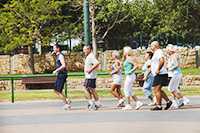Worksite Physical Activity

A worksite wellness program that includes a physical activity component can help maintain a healthier workforce. A healthier workforce can benefit from reduced direct costs associated with health care expenses.1,2 The worksite wellness program also has potential to increase employees’ productivity 3,4 reduce absenteeism,1,4 and increase morale.5 Additionally, these programs are often seen as a central component of an attractive employee compensation and benefits package that can be used as a recruitment and retention tool to attract and keep high quality employees.5 Worksites can encourage physical activity through a multicomponent approach of offering management support, physical access to opportunities, policies, and social support programs.

Regardless of size, resources, setting, and type all worksites can provide opportunities to promote physical activity for their employees. CDC’s Division of Nutrition, Physical Activity, and Obesity supports worksite wellness programs to increase physical activity because of the following:
- There are numerous health benefits related to physical activity. These health benefits include a lower risk of chronic diseases such as diabetes, heart disease and stroke, some cancers, and depression.6
- Only half of all American adults report meeting the physical activity guidelines.7
- Each day in the United States, more than 150 million American adults participate in the labor force.8
- With employees spending 7.6 hours a day on average at their place of employment, worksites provide a unique setting to promote practices that can significantly increase physically active employees and potentially affect the health of millions of working adults.9
- Many barriers to physical activity can be addressed by worksite physical activity programs. For example, a simple walking path that provides employees with the opportunity to walk at work may address barriers such as not having time to walk, concerns about neighborhood safety, or lack of social support.
Selected Resources
-
Walk This Way: A Resource on State and Local Policies That Support Physical Activity and Wellness in and Around the Workplace [PDF-5.57MB]
Developed by ChangeLab Solutions, this resource outlines state and local policies that support physical activity and wellness in and around the workplace. - Physical Activity in the Workplace: A Guide for Employers [PDF-338KB]
-
Current Practices in Worksite Wellness Initiatives [PDF-3.01MB]
Six states working to implement worksite wellness initiative by using strategies such as programs, policies, environmental supports, or community links to promote the health of their employees. - Manager and Supervisor Support for Worksite Health Promotion Programs Integrative Literature Review [PDF-171KB]
-
Worksite Physical Activity Highlights in Kentucky[PDF-724KB]
These highlights examine the successful implementation of a worksite physical activity program in the Kentucky Department of Education and Department of Health. -
Worksite Physical Activity Highlights in Mississippi[PDF-273KB]
These highlights explore evidence-based strategies to bring worksite physical activity to more people in Mississippi agencies. -
Worksite Physical Activity Highlights in Utah[PDF-2.55KB]
These highlights explore early evidence for successful practices in an area in Utah where practitioners are currently searching for understandable, common language advice in how to help staff members manage health at work.
References
- Naydeck BL, Pearson JA, Ozminkowski RJ, Day BT, Goetzel RZ. The impact of the Highmark employee wellness programs on 4-year health care costs. J Occup Environ Med. 2008;50(2):146-156.
- Baicker K, Cutler D, Song Z. Workplace wellness programs can generate savings. Health Affairs. 2010; 29(2):1-8.
- Goetzel, RZ, Ozminkowski, RJ. The health and cost benefits of work site health-promotion programs. Annu Rev Public Health. 2008;29:303-323.
- Mills PR, Kessler RC, Cooper J, Sullivan S. Impact of a health promotion program on employee health risks and work productivity. Am J Health Promot. 2007;22(1):45‐53.
- Centers for Disease Control and Prevention. Steps to Wellness: A Guide to Implementing the 2008 Physical Activity Guidelines for Americans in the Workplace [PDF – 3M]. Atlanta, GA: US Department of Health and Human Services; 2012. Accessed November 11, 2014.
- Physical Activity Guidelines Advisory Committee. Physical Activity Guidelines Advisory Committee Report, 2008. Washington, DC: US Department of Health and Human Services; 2008.
- Paul P. Analysis of data from the 2013 National Health Interview Survey. Accessed May 25, 2015.
- U.S. Department of Labor. Bureau of Labor Statistics. Employment Situation Summary Table A. Household data, seasonally adjusted. 2014. Accessed January 7, 2015.
- American Time Use Survey—2013 Results [PDF-271KB]. Accessed May 27, 2015.
- Page last reviewed: September 28, 2017
- Page last updated: September 28, 2017
- Content source:



 ShareCompartir
ShareCompartir